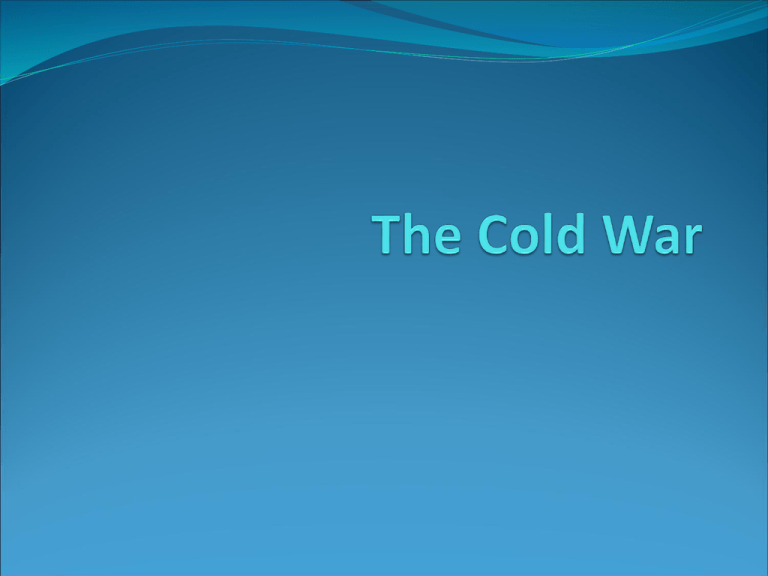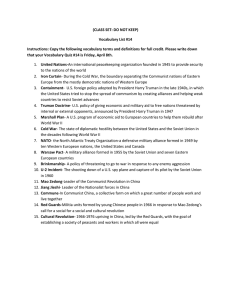The Cold War - Aurora Public Schools
advertisement

1945: A Pivotal Year Harry S. Truman become President WWII ends after Atomic-Bombs are dropped United Nations formed. International peace keeping body consisting of 50 nations. Tensions Mount Following WWII: Josef Stalin of Russia established communist governments in much of Eastern Europe. Called these satellite nations. Iron Curtain: Term referring to the division between East and West Europe. Germany Split into EAST and WEST GERMANY! U.S. and Containment Containment – U.S. pledge to take measures to prevent any extension of communist rules to other countries. Cold War and The Truman Doctrine Cold War – A state of hostility, without direct military conflict, that developed between the United States and the Soviet Union after WWII. Truman Doctrine – President Truman’s pledge to provide military and financial aid to countries resisting communism. America’s response to their fear of spreading communism. The Marshall Plan Marshall Plan – Gave $ to war torn nations of Europe. Purpose: To help European countries gain economic stability and build stable democracies, which would then help stop the spread of communism. The Berlin Airlift 1948 – Germany split into East Germany (Communist) and West Germany (NonCommunist). Berlin also split into East and West Berlin… BERLIN WALL BUILT! The Berlin Airlift – American and British forces airlifted food and supplies into the Blockaded West Berlin. NATO and the Warsaw Pact NATO – 1949, 10 Western European countries plus the U.S. and Canada formed a defensive military alliance to protect against Soviet aggression. Warsaw Pact – Soviet / Communist version of NATO. Korean War Causes Following WWII, Korea was divided along the 38th Parallel. North Korea - pro-Communist South Korea - pro American 1950 – North Korea invaded South Korea in an attempt to unite Korea under one Communist Regime. Korean War U.S enter the war on the side of South Korea…. TRUMAN DOCTRINE… Provided air, sea, and ground support Korean War After initial success, Chinese communist forces halted the U.N. forces and the war resulted in a twoyear stalemate along the 38th parallel. THE RESULT Korea remained divided along the 38th parallel. NOTHING CHANGED, but Communism was contained. Writing Assignment In your notebooks and in complete sentences write a four to five sentence paragraph answering the following question: Considering containment and the Truman Doctrine, do you think the Korean War was a success or a failure? Why? The Cold War At Home HUAC – House Un-American Activities Committee, Investigated people suspected of communist influence both inside and outside of the government. Hollywood Ten Blacklists Alger Hiss Julius and Ethel Rosenberg Joseph McCarthy’s “Witch Hunts” Joseph McCarthy – Anti-Communist Republican Senator from Wisconsin. McCarthyism – McCarthy’s practice of accusing people of being Communists without providing sufficient evidence. Eisenhower and the Cold War 1953: Dwight D. Eisenhower elected President. Brinkmanship – The willingness of the U.S. under Eisenhower to go to the brink of all out war with the Soviet Union. Eisenhower Doctrine – Said that the U.S. would defend the Middle East against an attack by any communist country. Eisenhower and the Domino Theory Domino Theory – If one Asian country would fall to communism, then others would fall in a domino like effect. Cold War and the Skies Sputnik – Soviet satellite that was the first artificial satellite ever sent into space. Confirmed American fears of Soviet technological superiority. U.S. starts NASA. U-2 Incident –American U-2 spy plane was shot down over Russia. Intensified the Cold War conflict. John F. Kennedy Democratic congressman. U.S. Navy Veteran. Young (43 years old). Catholic. Won the election of 1960 (defeated Richard Nixon). Kennedy Takes Office No mandate- public endorsement of proposals. “New Frontier”- Term referring to Kennedy’s proposals to improve the economy, assist the poor, and speed up the space program. The Bay of Pigs April 17, 1961 The Plan: Cuban refugees trained by the CIA would invade Cuba and overthrow Fidel Castro. The Result: TOTAL DISASTER!!! U.S. looks ignorant and incompetent… Cuban Missile Crisis October 16, 1962- Spy plane photos revealed Soviet missile bases being built in Cuba. Cuban Missile Crisis followed- A stand off between the S.U. and U.S. that nearly led to nuclear war. Cuban Missile Crisis Kennedy’s Options: Negotiate with Khrushchev. Invade Cuba. Blockade Cuba. Bomb the missile sites. Activity In a well organized four to five sentence paragraph in your notebooks, state which of the options you would choose and why. The Cuban Missile Crisis Kennedy’s decision: Naval Quarantine Khrushchev agreed to remove missiles and Kennedy removed the blockade. Kennedy removed missiles from Turkey. Cuban Missile Crisis The Aftermath: Limited Test Ban Treaty: Banned nuclear testing above ground Writing Activity Situation: You are a journalist for the New York Times and the Cuban Missile Crisis has just ended. Your Editor in Chief has just asked you to write an article recapping the event, describing who, what, when, where, and why the event took place. GET TO WORK!





